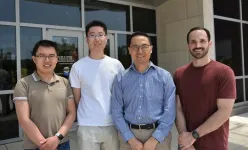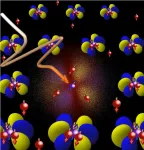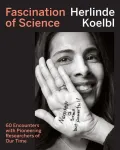(Press-News.org) People solve new problems readily without any special training or practice by comparing them to familiar problems and extending the solution to the new problem. That process, known as analogical reasoning, has long been thought to be a uniquely human ability.
But now people might have to make room for a new kid on the block.
Research by UCLA psychologists shows that, astonishingly, the artificial intelligence language model GPT-3 performs about as well as college undergraduates when asked to solve the sort of reasoning problems that typically appear on intelligence tests and standardized tests such as the SAT. The study is published in Nature Human Behaviour.
But the paper’s authors write that the study raises the question: Is GPT-3 mimicking human reasoning as a byproduct of its massive language training dataset or it is using a fundamentally new kind of cognitive process?
Without access to GPT-3’s inner workings — which are guarded by OpenAI, the company that created it — the UCLA scientists can’t say for sure how its reasoning abilities work. They also write that although GPT-3 performs far better than they expected at some reasoning tasks, the popular AI tool still fails spectacularly at others.
“No matter how impressive our results, it’s important to emphasize that this system has major limitations,” said Taylor Webb, a UCLA postdoctoral researcher in psychology and the study’s first author. “It can do analogical reasoning, but it can’t do things that are very easy for people, such as using tools to solve a physical task. When we gave it those sorts of problems — some of which children can solve quickly — the things it suggested were nonsensical.”
Webb and his colleagues tested GPT-3’s ability to solve a set of problems inspired by a test known as Raven’s Progressive Matrices, which ask the subject to predict the next image in a complicated arrangement of shapes. To enable GPT-3 to “see,” the shapes, Webb converted the images to a text format that GPT-3 could process; that approach also guaranteed that the AI would never have encountered the questions before.
The researchers asked 40 UCLA undergraduate students to solve the same problems.
“Surprisingly, not only did GPT-3 do about as well as humans but it made similar mistakes as well,” said UCLA psychology professor Hongjing Lu, the study’s senior author.
GPT-3 solved 80% of the problems correctly — well above the human subjects’ average score of just below 60%, but well within the range of the highest human scores.
The researchers also prompted GPT-3 to solve a set of SAT analogy questions that they believe had never been published on the internet — meaning that the questions would have been unlikely to have been a part of GPT-3’s training data. The questions ask users to select pairs of words that share the same type of relationships. (For example, in the problem “‘Love’ is to ‘hate’ as ‘rich’ is to which word?,” the solution would be “poor.”)
They compared GPT-3’s scores to published results of college applicants’ SAT scores and found that the AI performed better than the average score for the humans.
The researchers then asked GPT-3 and student volunteers to solve analogies based on short stories — prompting them to read one passage and then identify a different story that conveyed the same meaning. The technology did less well than students on those problems, although GPT-4, the latest iteration of OpenAI’s technology, performed better than GPT-3.
The UCLA researchers have developed their own computer model, which is inspired by human cognition, and have been comparing its abilities to those of commercial AI.
“AI was getting better, but our psychological AI model was still the best at doing analogy problems until last December when Taylor got the latest upgrade of GPT-3, and it was as good or better,” said UCLA psychology professor Keith Holyoak, a co-author of the study.
The researchers said GPT-3 has been unable so far to solve problems that require understanding physical space. For example, if provided with descriptions of a set of tools — say, a cardboard tube, scissors and tape — that it could use to transfer gumballs from one bowl to another, GPT-3 proposed bizarre solutions.
“Language learning models are just trying to do word prediction so we’re surprised they can do reasoning,” Lu said. “Over the past two years, the technology has taken a big jump from its previous incarnations.”
The UCLA scientists hope to explore whether language learning models are actually beginning to “think” like humans or are doing something entirely different that merely mimics human thought.
“GPT-3 might be kind of thinking like a human,” Holyoak said. “But on the other hand, people did not learn by ingesting the entire internet, so the training method is completely different. We’d like to know if it’s really doing it the way people do, or if it’s something brand new — a real artificial intelligence — which would be amazing in its own right.”
To find out, they would need to determine the underlying cognitive processes AI models are using, which would require access to the software and to the data used to train the software — and then administering tests that they are sure the software hasn’t already been given. That, they said, would be the next step in deciding what AI ought to become.
“It would be very useful for AI and cognitive researchers to have the backend to GPT models,” Webb said. “We’re just doing inputs and getting outputs and it’s not as decisive as we’d like it to be.”
END
GPT-3 can reason about as well as a college student, UCLA psychologists report
But does the technology mimic human reasoning or is it using a fundamentally new cognitive process?
2023-07-31
ELSE PRESS RELEASES FROM THIS DATE:
Associations of military-related traumatic brain injury with new-onset mental health conditions and suicide risk
2023-07-31
About The Study: In this study including 860,000 soldiers, rates of new-onset mental health conditions were higher among individuals with a history of military-related traumatic brain injury (TBI) compared with those without. Moreover, risk for suicide was both directly and indirectly associated with history of TBI.
Authors: Lisa A. Brenner, Ph.D., of the VHA Rocky Mountain Mental Illness Research Education and Clinical Center in Aurora, Colorado, is the corresponding author.
To access the embargoed study: Visit our For The Media website at this link ...
Association of racial and ethnic identity with attrition from M.D.-Ph.D. Training programs
2023-07-31
About The Study: This study found significant racial and ethnic disparities in attrition from M.D.-Ph.D. training, where Black students had greater than 50% higher odds of leaving M.D.-Ph.D. training than their peers. Notably, compared with 17% of white students, 29% of Black M.D.-Ph.D. students did not complete their training.
Authors: Mytien Nguyen, M.S., of the Yale School of Medicine in New Haven, Connecticut, is the corresponding author.
To access the embargoed study: Visit our For The Media website at this link https://media.jamanetwork.com/
(doi:10.1001/jamainternmed.2023.2822)
Editor’s ...
Association between gestational age and academic achievement of children born at term
2023-07-31
About The Study: The findings of this study of more than 500,000 children suggest that there is no evidence of a difference in math and reading scores over grades 2 to 11 among children born between 39 and 40 weeks’ gestation, and overall no evidence of better scores among those born at 41 weeks’ gestation compared with 40 weeks’ gestation. The results can further inform decisions on delivery timing at term birth by offering insights into long-term associations of delivery timing with cognitive development and school achievement.
Authors: George L. Wehby, M.P.H., Ph.D., of ...
CABBI develops eco-friendly enzyme to create key chemical building blocks
2023-07-31
Using energy from light to activate natural enzymes can help scientists create new-to-nature enzymatic reactions that support eco-friendly biomanufacturing — the production of fuels, plastics, and valuable chemicals from plants or other biological systems.
Applying this photoenzymatic approach, researchers have developed a clean, efficient way to synthesize crucial chemical building blocks known as chiral amines, solving a longstanding challenge in synthetic chemistry.
The study, published in Nature Catalysis, ...
When electrons slowly vanish during cooling
2023-07-31
Many substances change their properties when they are cooled below a certain critical temperature. Such a phase transition occurs, for example, when water freezes. However, in certain metals there are phase transitions that do not exist in the macrocosm. They arise because of the special laws of quantum mechanics that apply in the realm of nature’s smallest building blocks. It is thought that the concept of electrons as carriers of quantized electric charge no longer applies near these exotic phase transitions. Researchers at the University of Bonn and ETH Zurich have now ...
BU commentary: Including sexual and gender minority populations in medical research guarantees the health and well-being of all
2023-07-31
(Boston)—In the face of ongoing political threats to the rights and well-being of sexual and gender minority (SGM) populations, public health and health care institutions and practitioners must explicitly address the needs of marginalized populations while ensuring that those with multiple marginalized identities are well represented in research, according to a commentary in JAMA Network Open.
“If we continue to exclude SGM in research, we will remain oblivious to the troubles they face in achieving health and well-being,” said lead author Carl G. Streed, Jr., MD, MPH, FACP, ...
Luzio, who lived in São Paulo 10,000 years ago, was Amerindian like Indigenous people now, DNA reveals
2023-07-31
An article to be published on July 31 in Nature Ecology & Evolution reveals that Luzio, the oldest human skeleton found in São Paulo state (Brazil), was a descendant of the ancestral population that settled the Americas at least 16,000 years ago and gave rise to all present-day Indigenous peoples, such as the Tupi.
Based on the largest set of Brazilian archeological genomic data, the study reported in the article also offers an explanation for the disappearance of the oldest coastal communities, who built the icons of Brazilian archeology known as sambaquis, huge mounds of shells and fishbones used as dwellings, cemeteries and territorial boundaries. Archeologists often ...
Bees evolved from ancient supercontinent, diversified faster than suspected
2023-07-31
The first bees evolved on an ancient supercontinent more than 120 million years ago, diversifying faster and spreading wider than previously suspected, a new study shows.
Led by Washington State University researchers, the study provides a new best estimate for when and where bees first evolved. Newly published in the journal Current Biology, the project reconstructed the evolutionary history of bees, estimated their antiquity, and identified their likely geographical expansion around the world.
The results indicate their point of origin was in western Gondwana, an ancient supercontinent that at that time included today's continents of Africa and South America.
“There’s ...
New algorithm ensnares its first ‘potentially hazardous’ asteroid
2023-07-31
Link to Google Drive folder containing images, videos and caption/credit information:
https://drive.google.com/drive/folders/19LP7UZbVKkTXSFds6DaKSy1lp014Hw4z?usp=sharing
Link to release:
https://www.washington.edu/news/2023/07/31/heliolinc3d/
FROM: James Urton
University of Washington
+1 206-543-2580
jurton@uw.edu
Ranpal Gill
Vera C. Rubin Observatory
+1 520-309-6195
rgill@lsst.org
Note: Researcher contact information at the end
For ...
Fascination of Science: 60 Encounters with Pioneering Researchers of Our Time
2023-07-31
What makes a brilliant scientist? Who are the people behind the greatest discoveries of our time? Connecting art and science, photographer Herlinde Koelbl seeks the answers in this English translation of the German book Fascination of Science, an indelible collection of portraits of and interviews with sixty pioneering scientists of the twenty-first century. Koelbl's approach is intimate and accessible, and her highly personal interviews with her subjects reveal the forces (as well as the personal quirks) that motivate the scientists' work; for example, one wakes up at 3 am because ...
LAST 30 PRESS RELEASES:
Eye for trouble: Automated counting for chromosome issues under the microscope
The vast majority of US rivers lack any protections from human activities, new research finds
Ultrasound-responsive in situ antigen "nanocatchers" open a new paradigm for personalized tumor immunotherapy
Environmental “superbugs” in our rivers and soils: new one health review warns of growing antimicrobial resistance crisis
Triple threat in greenhouse farming: how heavy metals, microplastics, and antibiotic resistance genes unite to challenge sustainable food production
Earthworms turn manure into a powerful tool against antibiotic resistance
AI turns water into an early warning network for hidden biological pollutants
Hidden hotspots on “green” plastics: biodegradable and conventional plastics shape very different antibiotic resistance risks in river microbiomes
Engineered biochar enzyme system clears toxic phenolic acids and restores pepper seed germination in continuous cropping soils
Retail therapy fail? Online shopping linked to stress, says study
How well-meaning allies can increase stress for marginalized people
Commercially viable biomanufacturing: designer yeast turns sugar into lucrative chemical 3-HP
Control valve discovered in gut’s plumbing system
George Mason University leads phase 2 clinical trial for pill to help maintain weight loss after GLP-1s
Hop to it: research from Shedd Aquarium tracks conch movement to set new conservation guidance
Weight loss drugs and bariatric surgery improve the body’s fat ‘balance:’ study
The Age of Fishes began with mass death
TB harnesses part of immune defense system to cause infection
Important new source of oxidation in the atmosphere found
A tug-of-war explains a decades-old question about how bacteria swim
Strengthened immune defense against cancer
Engineering the development of the pancreas
The Journal of Nuclear Medicine ahead-of-print tip sheet: Jan. 9, 2026
Mount Sinai researchers help create largest immune cell atlas of bone marrow in multiple myeloma patients
Why it is so hard to get started on an unpleasant task: Scientists identify a “motivation brake”
Body composition changes after bariatric surgery or treatment with GLP-1 receptor agonists
Targeted regulation of abortion providers laws and pregnancies conceived through fertility treatment
Press registration is now open for the 2026 ACMG Annual Clinical Genetics Meeting
Understanding sex-based differences and the role of bone morphogenetic protein signaling in Alzheimer’s disease
Breakthrough in thin-film electrolytes pushes solid oxide fuel cells forward
[Press-News.org] GPT-3 can reason about as well as a college student, UCLA psychologists reportBut does the technology mimic human reasoning or is it using a fundamentally new cognitive process?





